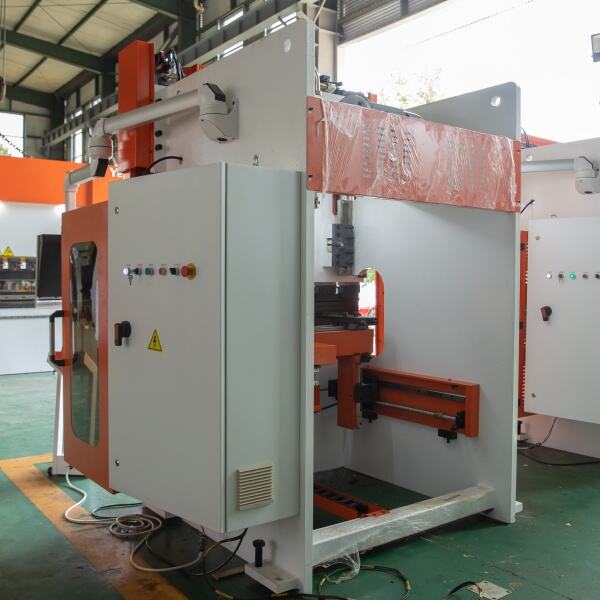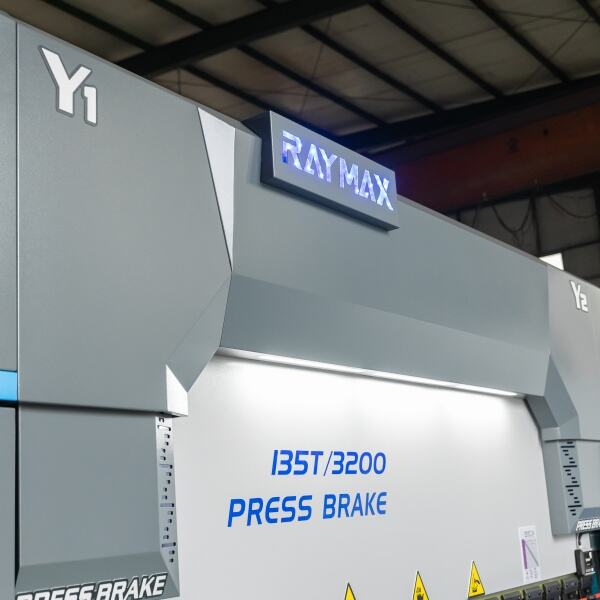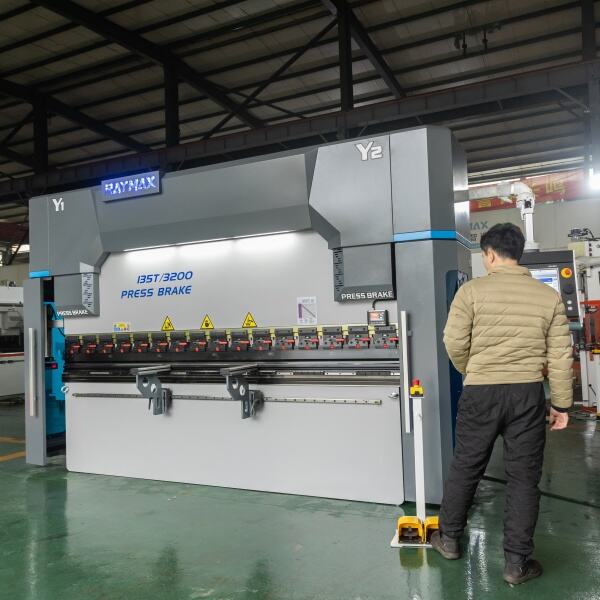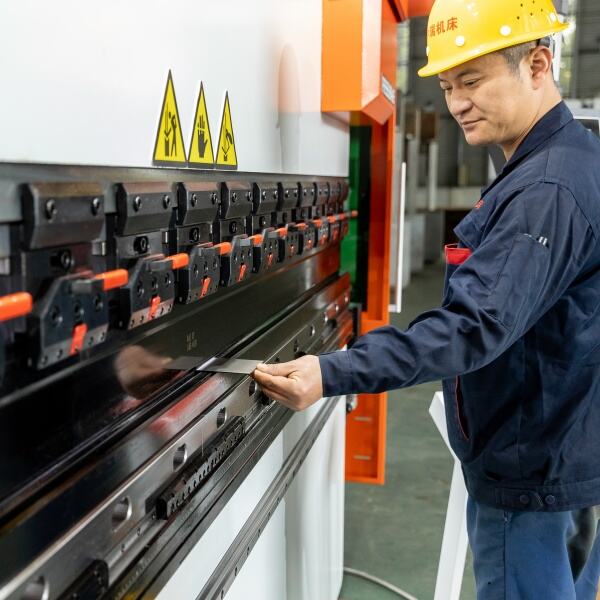
การปฏิบัติงานเครื่องดัด CNC press brake ครอบคลุมกระบวนการทั้งหมดตั้งแต่การตั้งค่า การเขียนโปรแกรม การเดินเครื่อง และการบำรุงรักษาเครื่อง เพื่อดัดแผ่นโลหะและโครงสร้างโลหะให้ได้ความแม่นยำและประสิทธิภาพ ซึ่งเป็นกระบวนการที่ต้องปฏิบัติตามมาตรการความปลอดภัย มีความเชี่ยวชาญทางเทคนิค และเข้าใจศักยภาพของเครื่องจักรอย่างถ่องแท้ ที่ RAYMAX เครื่อง CNC press brake ของเราได้รับการออกแบบมาเพื่อให้การปฏิบัติงานเป็นไปอย่างราบรื่น พร้อมทั้งรับประกันความปลอดภัยและคุณภาพ โดยมีคุณสมบัติที่รองรับทั้งผู้ปฏิบัติงานที่มีประสบการณ์และผู้ที่เพิ่งเริ่มใช้งานเทคโนโลยีนี้ ด้านล่างนี้คือการวิเคราะห์อย่างละเอียดเกี่ยวกับการปฏิบัติงานเครื่อง CNC press brake ที่ปรับให้เหมาะสมกับอุตสาหกรรมที่เราให้บริการ (ยานยนต์ เรือ รถไฟ เครื่องบิน พลังงาน ปิโตรเคมี และอุตสาหกรรมเบา) และสอดคล้องกับการออกแบบเครื่องจักรของเรา 1. การเตรียมการก่อนปฏิบัติงาน: ความปลอดภัยและการตรวจสอบอุปกรณ์ ขั้นตอนแรกในการปฏิบัติงานเครื่อง CNC press brake คือการสร้างสภาพแวดล้อมการทำงานที่ปลอดภัย และตรวจสอบให้แน่ใจว่าเครื่องจักรอยู่ในสภาพที่เหมาะสม ผู้ปฏิบัติงานต้องสวมใส่อุปกรณ์ป้องกันส่วนบุคคล (PPE) ตามบังคับ ได้แก่ แว่นตาความปลอดภัย (เพื่อป้องกันเศษโลหะกระเด็นเข้าตา) รองเท้าหัวเหล็ก (เพื่อป้องกันการบาดเจ็บที่เท้าจากวัสดุหนัก) และถุงมือกันตัด (เพื่อป้องกันการบาดจากขอบโลหะคม) ต่อจากนั้น ผู้ปฏิบัติงานจะตรวจสอบเครื่องจักรโดยละเอียด: - ระบบไฮดรอลิก: ตรวจสอบระดับน้ำมันไฮดรอลิก (ให้อยู่ระหว่างขีด "min" และ "max" บนถังน้ำมัน) ตรวจสอบท่อและข้อต่อว่ามีการรั่วหรือไม่ (แม้แต่รอยรั่วเล็กน้อยก็อาจลดแรงดันและทำให้การดัดไม่แม่นยำได้) และตรวจสอบให้แน่ใจว่าน้ำมันยังสะอาดอยู่ (น้ำมันที่มืดหรือขุ่นแสดงว่าต้องเปลี่ยน) - อุปกรณ์เครื่องมือ: ตรวจสอบหัวดัด (punch) และแม่พิมพ์ (die) ว่ามีรอยสึกหรือรอยร้าวหรือไม่ (เครื่องมือที่สึกหรออาจทำให้เกิดครีบหรือการดัดที่ไม่สม่ำเสมอได้) ตรวจสอบให้แน่ใจว่าเครื่องมือถูกยึดไว้กับตัว ram และฐานเครื่องแน่นหนา เพราะเครื่องมือที่หลวมอาจเคลื่อนตัวขณะทำงาน ทำให้เกิดอันตรายหรือชิ้นงานบกพร่อง - ระบบ CNC: เปิดไฟหลักและระบบควบคุม CNC ตรวจสอบว่ามีข้อความแสดงข้อผิดพลาดหรือไฟเตือนหรือไม่ ตรวจสอบให้แน่ใจว่าระบบควบคุมทำงานได้ปกติ เช่น ทดสอบการตอบสนองของหน้าจอสัมผัส และความสามารถในการจัดเก็บโปรแกรม - คุณสมบัติความปลอดภัย: ทดสอบปุ่มหยุดฉุกเฉิน (กดแต่ละปุ่มเพื่อให้แน่ใจว่าเครื่องจักรดับทันที) และทดสอบระบบแสงกันเข้าถึง (light curtains) โดยการยื่นมือผ่านลำแสงเพื่อตรวจสอบว่าเครื่องหยุดทำงานหรือไม่ การตรวจสอบนี้มีความสำคัญมากในการป้องกันอุบัติเหตุและการหยุดทำงาน ตัวอย่างเช่น ผู้ปฏิบัติงานของลูกค้าด้านปิโตรเคมีสังเกตเห็นรอยรั่วน้ำมันไฮดรอลิกเล็กน้อยขณะตรวจสอบก่อนเริ่มงาน จึงเปลี่ยนท่อใหม่ก่อนเริ่มการผลิต ซึ่งช่วยป้องกันการลดแรงดันที่อาจทำให้ชิ้นส่วนถังความดันสแตนเลสเสียหายได้ 2. การเตรียมวัสดุและเครื่องมือ เมื่อเครื่องจักรได้รับการตรวจสอบแล้ว ผู้ปฏิบัติงานจะเตรียมวัสดุและเครื่องมือสำหรับงานดัดเฉพาะทาง: - การเตรียมวัสดุ: แผ่นโลหะ (หรือโครงสร้างโลหะ) จะถูกตัดให้ได้ความยาวที่กำหนดโดยใช้เครื่องตัดแผ่น (shearing machine) หรือเครื่องเลเซอร์ไฟเบอร์ (fiber laser cutter) (ซึ่ง RAYMAX ก็จัดจำหน่ายเช่นกัน) ผู้ปฏิบัติงานตรวจสอบให้แน่ใจว่าวัสดุสะอาด โดยกำจัดสิ่งสกปรก น้ำมัน หรือสนิมออก เพราะสิ่งเจือปนเหล่านี้อาจทำให้เครื่องมือเสียหายหรือการดัดไม่แม่นยำได้ ตัวอย่างเช่น แผ่นอลูมิเนียมที่ใช้ในอุตสาหกรรมการบินต้องปราศจากน้ำมันเพื่อป้องกันการลื่นขณะดัด - การเลือกและติดตั้งเครื่องมือ: ผู้ปฏิบัติงานเลือก punch และ die ที่เหมาะสมตามชนิดของวัสดุ ความหนา และรูปทรงการดัดที่ต้องการ สำหรับการดัด 90 องศาบนแผ่นเหล็กกล้าคาร์บอนหนา 5 มม. โดยทั่วไปจะใช้ die รูปตัววีที่มีช่องเปิด 10 มม. ส่วนการดัดแบบโค้ง (เช่น สำหรับชิ้นส่วนตัวถังรถยนต์) จะเลือกใช้ die ที่มีรัศมี ผู้ปฏิบัติงานติดตั้งเครื่องมือบน ram (punch) และฐานเครื่อง (die) โดยใช้ประแจแรงบิด (torque wrench) เพื่อยึดตัวยึดตามข้อกำหนดของผู้ผลิต ปรับช่องว่างระหว่าง punch และ die ให้พอดีกับความหนาของวัสดุ ช่องว่างที่เล็กเกินไปอาจทำให้วัสดุบิดงอ ในขณะที่ช่องว่างใหญ่เกินไปอาจทำให้การดัดไม่สมบูรณ์ - การจัดวางวัสดุ: ผู้ปฏิบัติงานวางแผ่นโลหะบนฐานเครื่อง โดยจัดแนวให้ตรงกับตัวปรับตำแหน่งด้านหลัง (back gauge) ซึ่งเป็นตัวหยุดที่ปรับได้เพื่อให้การจัดวางแม่นยำ สำหรับเครื่อง CNC press brake ของเรา ตัวปรับตำแหน่งด้านหลังถูกควบคุมโดยระบบ CNC ทำให้สามารถปรับตั้งค่าได้อย่างแม่นยำ (±0.05 มม.) ผ่านหน้าจอสัมผัส ตัวอย่างเช่น เมื่อดัดชิ้นส่วนที่เหมือนกันหลายชิ้น (เช่น แผงตู้ควบคุมไฟฟ้าสำหรับอุตสาหกรรมเบา) ตัวปรับตำแหน่งด้านหลังจะช่วยให้แต่ละแผ่นวางในตำแหน่งเดียวกัน ทำให้การดัดสม่ำเสมอ 3. การเขียนโปรแกรม CNC: การป้อนค่าพารามิเตอร์การดัด ระบบควบคุม CNC จะถูกโปรแกรมเพื่อกำหนดลำดับและพารามิเตอร์การดัด ผู้ปฏิบัติงานสามารถเลือกโหลดโปรแกรมที่บันทึกไว้ล่วงหน้า (สำหรับงานที่ทำซ้ำ) หรือสร้างโปรแกรมใหม่ด้วยตนเอง: - การสร้างโปรแกรม: ผู้ปฏิบัติงานป้อนพารามิเตอร์สำคัญเข้าสู่ระบบ CNC รวมถึง: - ชนิดของวัสดุ (เช่น เหล็กกล้าคาร์บอน อลูมิเนียม สแตนเลส) และความหนา (เพื่อปรับแรงดัดและความเร็ว) - มุมการดัด (เช่น 90 องศา 135 องศา) และจำนวนการดัด (สำหรับชิ้นส่วนที่ต้องดัดหลายครั้ง) - ความเร็ว ram (เร็วสำหรับวัสดุบาง และช้าสำหรับวัสดุหนา เพื่อให้แรงกดสม่ำเสมอ) - ตำแหน่ง back gauge (เพื่อควบคุมระยะจากขอบแผ่นถึงจุดดัด) เครื่อง CNC press brake ของเราติดตั้งอินเตอร์เฟซที่ใช้งานง่าย พร้อมการแสดงผลการจำลอง 3 มิติ ซึ่งช่วยให้ผู้ปฏิบัติงานสามารถดูตัวอย่างกระบวนการดัดได้ การจำลองนี้มีประโยชน์มากสำหรับชิ้นส่วนซับซ้อน ตัวอย่างเช่น ผู้ปฏิบัติงานด้านยานยนต์ที่ต้องโปรแกรมการดัด 4 ขั้นตอนสำหรับชิ้นส่วนโครงรถ สามารถใช้การจำลองเพื่อตรวจสอบว่า punch จะไม่ชนกับ die ในการดัดขั้นตอนที่สาม ซึ่งช่วยลดการสูญเสียวัสดุ - การทดสอบโปรแกรม: เมื่อโปรแกรมถูกสร้างแล้ว ผู้ปฏิบัติงานบันทึกโปรแกรมและทดสอบดัดด้วยวัสดุตัวอย่าง ขั้นตอนนี้สำคัญมากในการตรวจสอบพารามิเตอร์ เช่น หากผลการทดสอบดัดได้มุม 88 องศาแทนที่จะเป็น 90 องศา ผู้ปฏิบัติงานจะปรับระยะการเคลื่อนที่ลงของ ram ในโปรแกรม CNC ให้เพิ่มขึ้น 0.5 มม. 4. การผลิตจริง: การตรวจสอบและการปรับตั้ง เมื่อการโปรแกรมได้รับการตรวจสอบแล้ว ผู้ปฏิบัติงานเริ่มการผลิตเต็มรูปแบบ: - เริ่มรอบการดัด: ผู้ปฏิบัติงานกดปุ่มเริ่มต้น และระบบ CNC จะดำเนินการตามโปรแกรม ram จะเคลื่อนตัวลง punch จะกดวัสดุลงใน die และเกิดการดัดขึ้น สำหรับเครื่อง CNC press brake แบบอัตโนมัติของเรา ระบบป้อนวัสดุอัตโนมัติจะช่วยโหลดและถอดวัสดุ ลดแรงงานคน - การตรวจสอบต่อเนื่อง: ผู้ปฏิบัติงานตรวจสอบเครื่องตลอดการผลิต เพื่อสังเกตสัญญาณผิดปกติ เช่น เสียงแปลกๆ (บ่งชี้ถึงปัญหาเครื่องมือหรือระบบไฮดรอลิก) การดัดไม่สม่ำเสมอ (บ่งชี้ว่าต้องปรับพารามิเตอร์) หรือวัสดุติดขัด (ซึ่งอาจทำให้เครื่องเสียหายได้) เครื่อง CNC press brake ของเราติดตั้งเซ็นเซอร์แบบเรียลไทม์ที่แจ้งเตือนผู้ปฏิบัติงานเมื่อเกิดปัญหา เช่น การเกินแรงดันหรือการจัดแนวเครื่องมือผิดพลาด และหยุดเครื่องโดยอัตโนมัติหากจำเป็น ตัวอย่างเช่น หากแผ่นเหล็กมีความหนามากกว่าที่คาดไว้ เซ็นเซอร์แรงดันจะตรวจจับการโอเวอร์โหลดและหยุดรอบการผลิตทันที เพื่อป้องกันการเสียหายของเครื่องมือ - การตรวจสอบคุณภาพ: ผู้ปฏิบัติงานตรวจสอบชิ้นงานเป็นระยะ โดยใช้เวอร์เนียร์คาลิเปอร์หรือเครื่องวัดพิกัด (coordinate measuring machine) เพื่อให้แน่ใจว่าตรงตามข้อกำหนด สำหรับอุตสาหกรรมที่ต้องการความแม่นยำสูงอย่างการบิน อาจต้องตรวจสอบทุกชิ้นที่ 10 ส่วนในอุตสาหกรรมเบา อาจตรวจสอบทุกชิ้นที่ 50 หากพบความผิดปกติ ผู้ปฏิบัติงานจะปรับพารามิเตอร์ของ CNC เช่น เพิ่มมุมการดัดขึ้น 1 องศา เพื่อแก้ไขการเด้งกลับของวัสดุ 5. การปิดเครื่องและการบำรุงรักษาหลังการใช้งาน เมื่อการผลิตเสร็จสิ้น ผู้ปฏิบัติงานดำเนินการปิดเครื่องตามขั้นตอน เพื่อให้เครื่องพร้อมใช้งานในครั้งต่อไป: - การปิดเครื่อง: ผู้ปฏิบัติงานดำเนินการให้เสร็จสิ้นงานผลิตในรอบปัจจุบัน จากนั้นปิดระบบ CNC และไฟหลัก เครื่องทำความสะอาดฐานเครื่องและเครื่องมือ โดยใช้แปรงขจัดเศษโลหะออก (ห้ามใช้อากาศอัดเพื่อเป่าเศษ เพราะอาจทำให้เศษกระจาย) และเช็ดพื้นผิวให้สะอาดด้วยผ้าแห้ง - การบำรุงรักษาเล็กน้อย: ผู้ปฏิบัติงานหล่อลื่นชิ้นส่วนเคลื่อนไหวของเครื่อง (เช่น ราง back gauge และตัวนำ ram) โดยใช้น้ำมันที่แนะนำ เครื่อง CNC press brake ของเราออกแบบจุดหล่อลื่นไว้อย่างชัดเจนเพื่อให้เข้าถึงได้ง่าย ผู้ปฏิบัติงานยังตรวจสอบระดับน้ำมันไฮดรอลิกอีกครั้ง และบันทึกข้อมูลการผลิต (เช่น จำนวนชิ้นงานที่ผลิต ปัญหาที่พบ) ลงในบันทึกการบำรุงรักษาเครื่อง - การเก็บรักษาเครื่องมือ: punch และ die จะถูกถอดออก (หากไม่ได้ใช้ในงานถัดไป) และเก็บไว้ในที่แห้งและสะอาด โดยทาด้วยน้ำมันกันสนิมเพื่อป้องกันการกัดกร่อน ที่ RAYMAX เรามีการฝึกอบรมการปฏิบัติงานเครื่อง CNC press brake อย่างครบถ้วนทั้งในสถานที่และผ่านระบบออนไลน์ ทีมเทคนิคของเราก็พร้อมให้การสนับสนุนอย่างต่อเนื่อง ช่วยผู้ปฏิบัติงานแก้ไขปัญหา (เช่น ข้อผิดพลาดของโปรแกรม การจัดแนวเครื่องมือ) และปรับปรุงประสิทธิภาพการทำงาน ไม่ว่าจะเป็นโรงงานอุตสาหกรรมเบาขนาดเล็ก หรือโรงงานผลิตในอุตสาหกรรมการบินขนาดใหญ่ เราตั้งเป้าหมายให้ผู้ปฏิบัติงานสามารถใช้เครื่อง CNC press brake ของเราได้อย่างปลอดภัย มีประสิทธิภาพ และเกิดประโยชน์สูงสุด ทั้งในด้านผลผลิตและคุณภาพ


